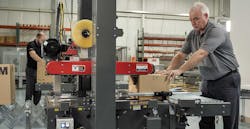In northern Illinois, contract manufacturer creative werks’ busy season is coming to an end. The co-packer has wrapped up production on a full range of confectionary consumables for the holidays—candy canes, form-filled pouches full of goodies, and the like. For this holiday run, the company’s three facilities were operating 40 production lines staffed with six to 24 workers on each, for all three shifts, six days a week.
It’s a lot of manual labor filling these boxes, and David Younk, creative werks’ director of manufacturing, has one goal for each worker, many seasonal, under his purview: "If they come in with a smile, I want them to leave with a smile," he says. "I want them to want to come back to work. There’s some intensive labor. If I can make their jobs easier, that’s one of the things I look for."
He says having the 3M-Matic Adjustable Case Sealer 7000a Pro to tape up the end-loader boxes at the end of the packaging process helps ensure that the work load is manageable.
The machine consists of a conveyor table with belt-driven tape heads overhead and below the cases passing through, seamlessly securing each package top and bottom almost instantaneously. According to manufacturer 3M, the maximum throughput is 40 boxes a minute; Younk says creative werks, which has a dozen machines, averages about 20.
They had an older model of the 3M-Matic, a line of case sealers that turns 50 next year, but shifted to another brand until a few years ago. The 7000a Pro came out in 2014 and that brought Younk back to the 3M.
"When I saw the updated versions, they renewed my faith in 3M’s products," Younk says. "One of the great things about the 7000a, once we set it up, I’m good to go for 4 months with very little worry of downtime."
For a co-packer that can change their lines for new SKU’s every couple of days, downtime isn’t really an option. And flexibility is a priority, as the box sizes that can range from 12 x 12 x 18 in. to 8 x 8 x 8 in. With a twist of the crank of the case sealer’s side, the top tape head conforms to the new specified height. And each time, the machine ingests the new box quickly and smoothly.
These don’t jam up," says Younk, who explains that the top head’s guidance keeps taller, skinnier boxes from tipping over. When you have high-volume operations, a random clog halting the flow would be most annoying to the person who has to unclog it. Eight hours of manual labor anywhere is tough enough, but it’s the little things like a clumsy machine breaking up your rhythm that can wipe that smile off your face.
Threading the tape into the head takes a minute, Younk says, though they earned additional tape heads for using 3M tape, which they keep at the ready for hot swaps.
So the change was noticed.
"The workers appreciated the move," the director says.
With so many jobs available out there, job satisfaction becomes paramount, and apparently this is only a microcosm of the business’ attempt to creative a positive environment. It has a stellar rating on Glassdoor.com (4.5 stars based of 8 reviews), where innovation and continuous improvement are common themes.
The only negative one engineering intern offered was that "you work with candy so if you eat a lot of it your stomach will hurt."
And a company like this needs humans, because flexibility and automation are at odds, having to sacrifice one for the other.
"We can’t truly automate and be flexible," Younk says.
A 7000a, he says can pay for itself in a year, though that’s not the most important factor.
"Having people come back the next season, because they enjoy their job, I would take that over ROI," he says.
Last month at PACK EXPO, 3M, known worldwide for its revolutionary Scotch tape, announced a new innovation for packing, one that could not only increase opportunities at co-packers, but also provide support to the ever-growing ecommerce industry.
Random Encounter
Called the 3M-Matic Random Case Sealer 7000r High Speed Pro, it looks nearly identical to the solution creative werks uses, with one major tweak. The upper head has been automated, allowing various sized boxes to all run down the same parade route without missing a beat, granted they are all between 3.25 and 27 in. in height. An add-on increases that to 13 to 36 in. Case length is at least 7 in., and width can range from 7 top 26 in.
"One thing we’ve had to do is structure so one size does fit all, so this would allow us to potentially broaden our horizon in what we can design," says Younk. "Not all consumers want the same exact thing."
The supply chain, however does want the same things: consistency, dependability—and the ability to change at a moment’s notice.
Tale of the Tape Dispenser
When you work in the tape business, you know not much is permanent. Something sticks for a while, and then loses out to the new trend.
That’s how the 3M-Matic was invented. Stapling and gluing boxes fell out of favor, as industry is always trying to continuously improve, and the time and quality of both of these options does not compare to applying a strip of tape.
Expecting someone to use a manual tape dispenser for eight hours a day, five days a week and also expecting uniform quality is completely impractical, so the table with rollers design was deployed. The Minnesota-based 3M could not confirm they were the very first to use the design, but affirmed they were one of the first.
The value proposition was simple, says Steve Schreiner, U.S. subsidiary business director for 3M’s industrial adhesives and tapes division: Sell customers on the "productivity, speed and lower cost per closed box" the company could provide with this new semi-autonomous, more ergonomic and repeatable solution.
The former Minnesota Mining & Manufacturing Co. certainly had the experience with the adhesive part, as the company invented modern tape. In the 1920s, its ambitious young lab technician/banjo player Richard Drew saw autobody painters using glue to cover the already completed portion of two-toned cars. The glue stuck to the surface and the job would often have to be touched up. Drew used a less sticky adhesive intended for the company’s sandpaper, combined it with crepe paper, and voila: Scotch masking tape was born. The "Scotch" part was meant to be an ethnically derisive poke at the frugal use of adhesive, but 3M embraced it. A few years later, the company figured out how to add adhesive to cellophane, to make Scotch transparent tape, a hit for the great many Depression-era penny pinchers who often had to mend over spend.
That’s the mythic part of the story, but what people don’t realize is how difficult it must have been to get all the key ingredients right.
It something Schreiner learned the value of when he started at 3M 35 years ago as a product development engineer.
"This can’t be that complicated; it’s just a roll of tape: sticky side down," Schreiner recalls thinking. "You start looking at what goes into that, the variety of chemistry that goes into making that adhesive work, properties that counteract each other."
He says it has to be tacky, but not so much that it sticks to the other side of the roll. Conversely, if it is not sticky enough, the roll will unfurl like a ball of yarn. Somehow, they figured out how to do all that without the use of artificial intelligence or the internet of things, or even the Internet itself.
Decades later, the packing division at 3M would need tape that was sturdy enough to keep boxes closed, but could quickly pull off the roll. Some of the first were, in keeping with the Scotch tradition, the Tartan and Highland brands.
The newest version, the 371+ tape, was designed to stick to highly recycled boxes, which have become more prevalent as companies work towards lowering cost and increasing sustainability.
Because of its history, convincing a potential buyer of 3M’s tape pedigree was probably easy for Schreiner, who in the 1990s ran 3M’s box-sealing business. Getting them to invest in a new piece of equipment may not have been. But Schreiner came with data. Using the older 700r random case sealer, they halved the time it took for a company to complete a complicated sealing procedure.
Sealing the Deal
The most apparent reason one would need an automated sealer is the same one automation has taken such a crucial role up and down the manufacturing supply chain: no one wants to do the job.
"There are less people available with a willingness to close boxes," Jorge Lopez, 3M business director for masking, packaging, and personal care products. "During the Christmas season, it becomes a mission impossible."
Along with that, more and more fulfillment centers are popping up. Soon the former book seller Amazon could rule the Americas, while Alibaba is slowly taking over Asia.
The 7000r obviously allows for faster throughput and requires less human interaction, and it isn’t a stretch to imagine a robotic arm lifting boxes into case sealers at some point. An overlooked benefit could be how eliminating the need for box uniformity could impact the supply chain.
"If you can reduce size of boxes, it’s a relevant savings for everybody,"’ Lopez says.
This is because often times a packager will load various sized products in one-size-fits-all boxes. You don’t need to be a lean expert to see that this wastes material.
"It’s not only about materials," Lopez says. "You are saving in cardboard, and also the cost of transportation."
This comes down to needlessly consuming volume. If each box was optimized for its contents, it stands to reason many more boxes could fit on the truck or pallet. Even if the haul’s weight is increased, this could be the difference between an extra order or more going out. Apply that to a whole supply chain and the efficiencies could grow exponentially.
Those saving could then be used for more value-added investment, like those AI and IoT projects you can’t get funding for, as opposed to spending on taping up boxes.
That’s something that will have employees and bosses alike start to smile.
About the Author
John Hitch
Editor, Fleet Maintenance
John Hitch, based out of Cleveland, Ohio, is the editor of Fleet Maintenance, a B2B magazine that addresses the service needs for all commercial vehicle makes and models (Classes 1-8), ranging from shop management strategies to the latest tools to enhance uptime.
He previously wrote about equipment and fleet operations and management for FleetOwner, and prior to that, manufacturing and advanced technology for IndustryWeek and New Equipment Digest. He is an award-winning journalist and former sonar technician aboard a nuclear-powered submarine where he served honorably aboard the fast-attack submarine USS Oklahoma City (SSN-723).



